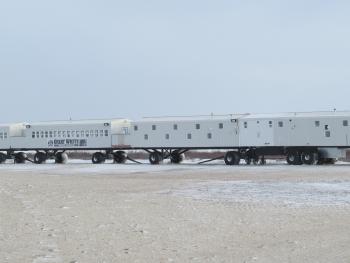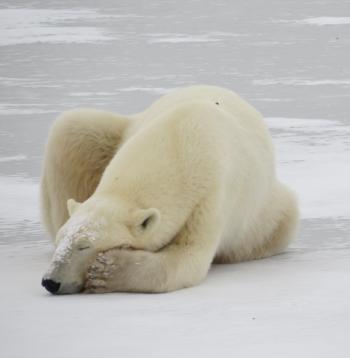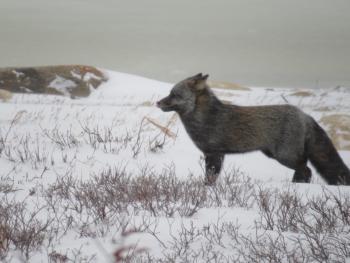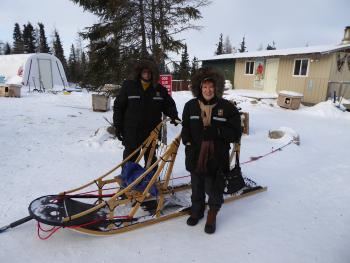A stay in the heart of Canada’s polar bear country
This article appears on page 42 of the November 2018 issue.
When my husband, Alan, decided that we should see the polar bears in Churchill, Canada, with a stay at the Tundra Lodge, I agreed because this winter 2017 journey was "his" trip. (Alan likes all exotic locations and physically active itineraries.) We booked the 7-day "Tundra Lodge Adventure" (including an extra day in Winnipeg) with Natural Habitat Adventures (Boulder CO; 800/543-8917, www.nathab.com) for the first week in November, a prime time to see the polar bears that congregate near the lodge while waiting for ice to form in nearby Hudson Bay.
Our package cost $17,996 for the two of us plus $1,416 (total) for our round-trip flights, also booked by Natural Habitat Adventures.
A day in Winnipeg
Our day in Winnipeg was wonderful. We stayed at the Fort Garry Hotel, one of Canada's old railway hotels, dating from 1913, with high ceilings and elegant chandeliers.
Our first stop at the hotel was the winter-gear room. Heavy parkas and insulated boots, both of which were needed, were provided for our use. With this winter outerwear, I was hardly ever cold, even though the temperature in Winnipeg registered 33°F or below. (In Churchill, it was 5°F and below.)
As far as other clothes were concerned, Natural Habitat advised us to pack long underwear, waterproof pants, warm hats, scarves and heavy, insulated socks and gloves. Although it wasn't mentioned, I'd also recommend taking a ski mask, as the wind coupled with the subzero temperatures was biting.
An excellent included breakfast fueled us for our wanderings before we headed out to the Canadian Museum for Human Rights (85 Israel Asper Way), a short, one-block walk away through the railroad terminal. This building, architecturally unusual both inside and out, sits on indigenous land and borrows images from Canada's landscape.
Enormous pink buttresses that represent roots hold the building firmly to the ground, while a glass front reflects the clouds in the sky. Stone walls represent Canada's mountains, and a tower symbolizes hope.
Inside, alabaster ramps lit from within lead to galleries on the upper floors. Each gallery tells stories of either human rights abuses or triumphs.
Although it would be worthwhile to linger in each gallery, we chose a 90-minute tour, on which a docent highlighted each gallery and gave us some free time to explore on our own.
We then took the free Downtown Spirit shuttle bus to the Manitoba Museum. This is a combination natural history/cultural museum featuring the natural history of the region and the history of the peoples of Manitoba, both indigenous and immigrant.
We arrived just in time for a traveling presentation by six actors called "Journey of a Lifetime." Each actor told the story of a different immigrant's journey to Canada to claim free land and start a new life.
Afterward, we wandered through the museum's many galleries, which featured local culture, Inuit history, geology of the area, etc. We could have spent an entire day at this museum.
Tundra Lodge
After a charter flight from Winnipeg to Churchill, our group, whom we'd met at a welcome dinner the night before, boarded the Polar Rover for the drive to the Tundra Lodge. The lodge is similar to a train, although it sits 5 feet off the ground, with viewing platforms between cars and access to the Polar Rovers through a back deck. (We were told our feet wouldn't touch the ground outside for the next four days.) These viewing platforms were handy for photographing the polar bears that came right up to the lodge.
When I first read about the lodge's accommodations, I was filled with trepidation. Each cabin was small (4'x8') and each was designed for a single person. My husband and I had adjacent cabins, mine with a lower bed and my husband's with an upper. Each had a shelf either over or under the bed, so there was actually enough room to organize one's belongings.
During our visit, there were 29 guests and two guides staying there, along with lodge staff. With a total of six bathrooms, only four with showers, we had to make do. However, we came to realize that staying there, as compared to staying in Churchill, enabled us to see more wildlife than those who stayed in town.
While the visitors who lodged at a hotel did have their own bathrooms, they had to leave each morning at 7 a.m. to travel 1½ hours just to reach polar bear country, where our lodge was situated.
As we were approaching the lodge for the first time, we couldn't wait to see polar bears, and we were rewarded almost immediately. Big, solitary male polar bears as well as mothers with their cubs of the year (nicknamed COY) in tow, greeted us even before we arrived.
Each day, half the group would go on safari on the Polar Rover in the morning and the other half in the afternoon. Morning and afternoon shifts were rotated daily. While one group was out of the lodge, the other could take showers, relax, socialize and listen to lectures.
The bears
There is a short window of time in the fall to see polar bears in this area because as soon as Hudson Bay freezes over, the bears head out on the ice to hunt ringed seals.
Hudson Bay is a huge, shallow, tidal inland sea with an outlet to the Arctic Ocean, so it allows polar bears to obtain the maximum amount of food with a minimum of activity. The bears stalk the seals, waiting patiently until a seal surfaces through a breathing hole to catch some air. With his elongated head and neck, a bear can snatch a seal even as it's retreating back under the ice.
Although the cubs look like adorable, cuddly teddy bears, an adult male is huge, weighing between 700 and 1,200 pounds and measuring 75 to 100 inches from the tip of its nose to the end of its tail.
When a polar bear stands, he can look in the windows of a Polar Rover, which stands on 5-foot tires above the tundra. When he walks, he trots, moving both legs on one side of his body forward with the same motion, and he can charge a resting seal in a leap at nearly 25 miles per hour.
A female polar bear can often be seen with one or two cubs, though we saw only mothers with one cub each.
Mothers and cubs are usually together for two years, after which the cubs are on their own. When the cubs become young adults, life is more precarious, as they must compete with larger, stronger males for seals and must learn to find their way, navigating currents, wind, landmasses and the changing coastlines.
However fascinating the lectures were, it was always with great joy that we boarded the Polar Rovers for more polar bear sightings.
Adding to our list of Arctic animals seen (despite their remarkable camouflage) were arctic foxes, red foxes and an arctic hare resting by a rock, motionless and almost totally camouflaged except for his black nose and eyes. A flock of pure-white ptarmigans almost escaped our notice as they settled on the snowy ground.
A nice surprise
Each day on the tundra was cold and clear, with nights quite blustery and cloudy. We were told when we booked the trip not to expect to see the northern lights, as they are generally not visible at that time of year because the skies are overcast. But one night, our guide came through the hallway calling "Northern lights!"
The winds had abated, the skies had cleared and the northern lights had appeared. My delighted husband grabbed his tripod and his Olympus E5 camera and was the only one to capture photographs of the lights in all their green glory.
A word about cameras. Most people on our trip had either professional-level or advanced-amateur DSLRs with several lenses, going up to 800mm. The polar bears generally were close but could be as far as 75-plus yards away, necessitating those longer lenses.
Alan also carried a fast f2.8 wide-angle lens, on the outside chance that the northern lights would be visible, and a tripod, which is the reason he was the only one who was successful in getting pictures of the lights.
The viewing platforms between the cars of the Tundra Lodge were grates, so tennis balls had to be added to the tripod's legs in order to balance it.
On our last day, a small snowstorm with frigid temps and howling winds almost kept us indoors. When our driver said visibility was clearing, we headed out; however, the ice was already forming on Hudson Bay, and the few polar bears we saw headed out on the ice to hunt.
At our tasty farewell dinner, we said good-bye to our very accommodating lodge staff, and early the next morning we were off to the town of Churchill.
A night in Churchill
Churchill is a very small town of 750 brave souls, with three hotels, two gift shops and a museum to cater to the tourists passing through. It lies on the western shore of Hudson Bay and is Canada's main port to the Arctic Ocean.
Polar bears draw visitors in the fall, but beluga whales draw them in the summer, northern lights in the winter and 200 species of birds in the spring.
The highlight of our day in Churchill was dogsledding, with dogs happy and excited to be racing the short, mile-long track. We each received a certificate claiming "Idid amile," a parody on Alaska's Iditarod race.
Just before we boarded our charter flight for the return to Winnipeg, we stopped by the polar bear jail. Frequently, in the summer, polar bears enter Churchill looking for food, making mischief and threatening the population. They are trapped and put in "jail," where they are housed in small cells with no windows and no food. (Polar bears generally eat little or nothing in the summer.) The bears are released usually in about a month or when the Hudson Bay freezes over.
Our day in Churchill over, we flew back to Winnipeg and the Fort Garry Hotel, where we returned our borrowed gear and reclaimed our checked belongings. After luxuriating in hot showers, another farewell dinner awaited us.
The next day we flew home, reminiscing about our time on the tundra and thankful we had stayed at the Tundra Lodge, the best hotel for polar bear viewing in the area.





